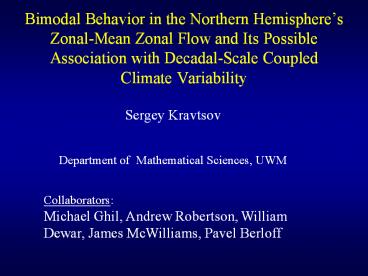Bimodal Behavior in the Northern Hemisphere
1 / 21
Title:
Bimodal Behavior in the Northern Hemisphere
Description:
... the Northern Hemisphere's Zonal-Mean Zonal Flow and Its ... Zonal-jet variability in the model. Wind-driven (WDC) and thermohaline (THC) circulation ... –
Number of Views:49
Avg rating:3.0/5.0
Title: Bimodal Behavior in the Northern Hemisphere
1
Bimodal Behavior in the Northern Hemispheres
Zonal-Mean Zonal Flow and Its Possible
Association with Decadal-Scale Coupled Climate
Variability
Sergey Kravtsov Department of Mathematical
Sciences, UWM
Collaborators Michael Ghil, Andrew Robertson,
William Dewar, James McWilliams, Pavel Berloff
2
Evidence for (multi)-decadal climate variability
- Positive evidence for (multi)-decadal climate
variability
- Statistical significance? Physical processes
ocean dynamics?
- Need for combination of observations and modeling
3
Coupled GCMs vs. intermediate climate models
4
Mid-Latitude Jet Stream
5
North Atlantic Oscillation and Arctic Oscillation
NAO
AO
6
A simple model
7
Zonal-jet variability in the model
8
Wind-driven (WDC) and thermohaline (THC)
circulation
Surface currents
9
Circulation in an ocean model
10
Oceans weather
11
Eddy-resolving ocean model
12
SST and NAO
- Decadal time scale detected in NAO/SST time
series
- Is this signal real? What dynamics does it
represent?
- AGCMs response to (small) SSTAs is weak and
model-dependent
SST tripole pattern (Marshall et al.
2001, Journal of Climate Vol. 14, No. 7,
pp. 13991421)
- Nonlinear small SSTAs large response??
13
Model geometry
14
Bimodality in atmospheric model and observations
15
Low-Frequency Oscillations (LFO) in the model
16
LFO in observations
17
Bimodality in the NH vs. SH
18
20-year oscillation in observations and WDC model
19
- High Ocean Energy High-
- Latitude (HL) O-Jet State
- HL ocean state A-jets
- Low-Latitude (LL) state
- O-Jet stays in HL state for
- a few years due to O-eddies
20
10-year oscillation in observations and THC model
21
Summary
- Mid-latitude winds may be nonlinearly sensitive
- to variations in external (to the atmosphere)
- forcing, which alters attraction basins of the
two - anomalously persistent atmospheric jet states
- Observed decadal climate variability in the
- North Atlantic region may be due, in part, to
a - combination of two coupled modes ocean
- eddy-driven adjustment mode and THC mode































